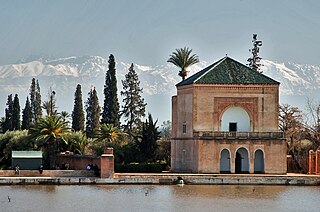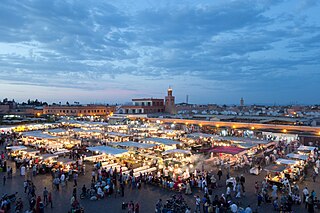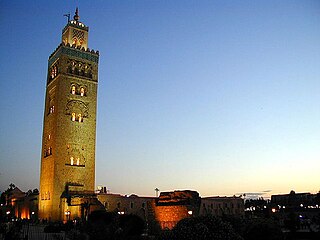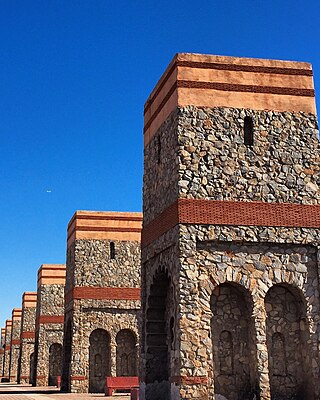
Marrakesh or Marrakech is the fourth-largest city in Morocco. It is one of the four imperial cities of Morocco and is the capital of the Marrakesh–Safi region. The city lies west of the foothills of the Atlas Mountains.

Jemaa el-Fnaa, also Jemaa el-Fna, Djema el-Fna or Djemaa el-Fnaa, is a square and market place in Marrakesh's medina quarter. It remains the main square of Marrakesh, used by locals and tourists.

The Kutubiyya Mosque or Koutoubia Mosque is the largest mosque in Marrakesh, Morocco. It is located in the southwest medina quarter of Marrakesh, near the Jemaa el-Fnaa market place, and is flanked by large gardens.

Bab er Robb is a southern city gate in the historic medina of Marrakech, Morocco.

Bab Agnaou, also transliterated as Bab Agnaw, is one of the best-known gates of Marrakesh, Morocco. Its construction is attributed to the Almohad caliph Abu Yusuf Ya'qub al-Mansur and was completed around 1188 or 1190.

The Almoravid Qubba, also known as the Qubba al-Ba'diyyin or Qubbaal-Barudiyyin, is a small monument in Marrakesh, Morocco. It was erected by the Almoravid dynasty in the early 12th century. It is notable for its extraordinary decoration and for being one of the only remnants of Almoravid architecture in Marrakesh.

This article describes notable landmarks, architecture, and museums in the city of Marrakesh, Morocco.

Almohad architecture corresponds to a period from the 12th to early 13th centuries when the Almohads ruled over the western Maghreb and al-Andalus. It was an important phase in the consolidation of a regional Moorish architecture shared across these territories, continuing some of the trends of the preceding Almoravid period and of Almoravid architecture.

The history of Marrakesh, a city in southern Morocco, stretches back nearly a thousand years. The country of Morocco itself is named after it.

The Ben Youssef Mosque, is a mosque in the Medina quarter of Marrakesh, Morocco, named after the Almoravid emir Ali ibn Yusuf. It is arguably the oldest and most important mosque in Marrakesh.
The Barrima Mosque is a mosque in Marrakesh, Morocco, attached to the Kasbah (citadel) and Royal Palace of the city. It was built in the late 18th century by the Alaouite sultan Muhammad ibn Abdallah.

The Kasbah of Marrakesh is a large walled district in the southern part of the medina of Marrakesh, Morocco, which historically served as the citadel (kasbah) and royal palace complex of the city. A large part of the district is still occupied by the official royal palace, the Dar al-Makhzen, which serves as the residence of the King of Morocco when he visits the city. The rest of the district consists of various neighbourhoods and monuments. It was founded by the Almohads in the late 12th century, with most of the construction carried out by Caliph Ya'qub al-Mansur. Two of its most important surviving structures today, the Kasbah Mosque and the main gate of Bab Agnaou, date from al-Mansur's reign.
The Battle of al-Buhayra was a battle between the Almoravid and the Almohad armies in May 1130 CE just outside Marrakesh, Morocco.

The Walls of Marrakesh are a set of defensive ramparts which enclose the historic medina districts of Marrakesh, Morocco. They were first laid out in the early 12th century by the Almoravid dynasty which founded the city in 1070 CE as their new capital. The walls have since been expanded several times by the addition of the Kasbah to the south at the end of the 12th century and by a later extension to encompass the northern neighbourhood around the Zawiya of Sidi Bel Abbes.

Sidi Yusuf ibn 'Ali as-Sanhaji is a wali who was born in Marrakesh, Morocco and died there in 1196 CE. He is considered one of the Seven Saints of Marrakesh, and one of the administrative divisions of Marrakesh is named after him.

Bab el-Khemis is the main northern gate of the medina of Marrakesh, Morocco.

The Seven Saints of Marrakesh or Patron Saints of Marrakesh are seven historical Muslim figures buried in Marrakesh, Morocco. Each of them was a famous Muslim jurisprudent, scholar or wali venerated for their piety or other mystical attributes. Their tombs form the basis of a centuries-old annual pilgrimage or ziyara, during which visitors pray at each of their tombs over seven days.

Bab Doukkala is the main northwestern gate of the medina of Marrakesh, Morocco.

Bab ad-Debbagh or Bab Debbagh is one of the main eastern gates of the medina of Marrakesh, Morocco.

Almoravid architecture corresponds to a period from the 11th to 12th centuries when the Almoravids ruled over the western Maghreb and al-Andalus. It was an important phase in the development of a regional Moorish architecture, as the styles and craftsmanship of al-Andalus were further imported and developed in North Africa. The Almoravids founded the city of Marrakesh as their capital and built many mosques in the region, although much of what they built has not preserved. The Almoravids were overthrown by the Almohads in the 12th century, after which Almohad architecture continued to develop some of the same trends in the Maghreb and al-Andalus.



















